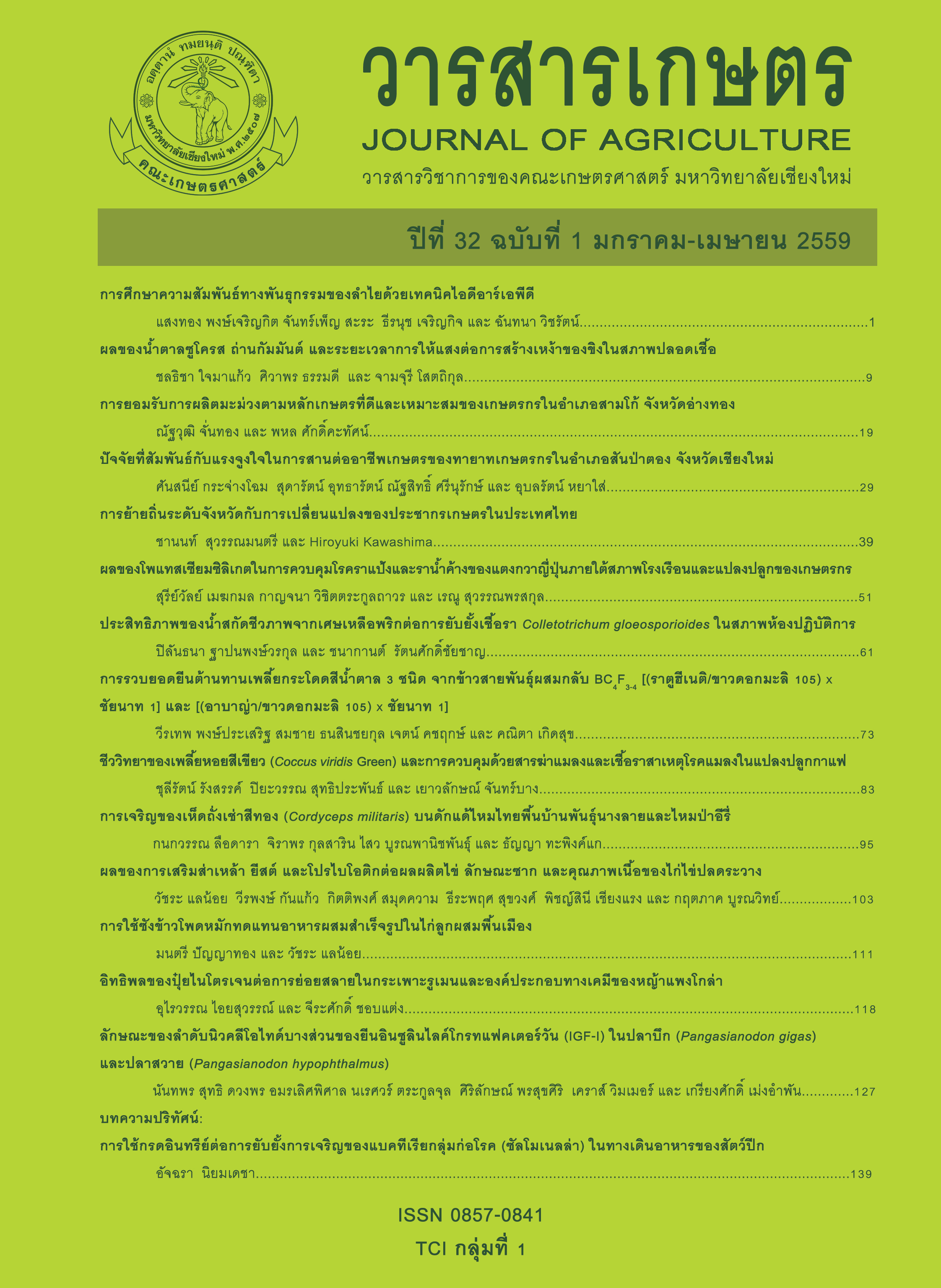การเจริญของเห็ดถั่งเช่าสีทอง (<I>Cordyceps militaris</I>) บนดักแด้ไหมไทยพื้นบ้านพันธุ์นางลายและไหมป่าอีรี่
Main Article Content
บทคัดย่อ
ศึกษาการเจริญเติบโตของเส้นใยและดอกเห็ดของเชื้อเห็ดถั่งเช่าสีทอง (Cordyceps militaris) ในดักแด้ไหม และสารออกฤทธิ์ที่มีสรรพคุณทางยาบนดักแด้ไหมไทยพื้นบ้านพันธุ์นางลาย (Bombyx mori)และไหมป่าอีรี่ (Samia ricini) ทดสอบกับเชื้อเห็ดถั่งเช่าสีทองจำนวน 2 สายพันธุ์ คือ CMRU-1 และ CM Saraburi โดยทำการทดลอง 3 กรรมวิธี คือ การฉีด การจุ่ม และการทำแผลแล้วจุ่มดักแด้ในเชื้อเห็ดถั่งเช่าสีทอง ผลการทดลองพบว่า กรรมวิธีการฉีดสารแขวนลอยเชื้อเห็ดถั่งเช่าสีทองสายพันธุ์ CMRU-1 เข้าตัวดักแด้ เป็นกรรมวิธีที่ดีที่สุด มีการเจริญเติบโตและสามารถเข้าก่อโรคกับดักแด้ไหมพันธุ์นางลายสูงสุด 72.50 เปอร์เซ็นต์ มีการเจริญของดอกเห็ดสูงสุด 85.50 เปอร์เซ็นต์ และดอกเห็ดมีน้ำหนักสด 42.70 กรัม ในขณะที่เชื้อเห็ดถั่งเช่าสีทองสายพันธุ์ CM Saraburi มีการเจริญเติบโตและสามารถเข้าก่อโรคกับดักแด้ไหมพันธุ์นางลาย 53.00 เปอร์เซ็นต์ และมีการเจริญของดอกเห็ด 88.70 เปอร์เซ็นต์ นอกจากนี้เชื้อเห็ดถั่งเช่าสีทองสายพันธุ์ CM Saraburi มีการเจริญเติบโตและสามารถเข้าก่อโรคกับดักแด้ไหมป่าอีรี่ 26.00 เปอร์เซ็นต์ มีการเจริญของดอกเห็ด 94.20 เปอร์เซ็นต์ และน้ำหนักสดดอกเห็ดอยู่ที่ 24.13 กรัม ในส่วนของการศึกษาสารออกฤทธิ์จากเห็ดถั่งเช่าสีทองที่เจริญบนดักแด้ไหมพบความแตกต่างของสารคอร์ไดซิปินและอะดีโนซินระหว่างส่วนดอกเห็ดและตัวดักแด้ โดยพบความเข้มข้นของสารคอร์ไดซิปินในดอกเห็ดของเชื้อเห็ดถั่งเช่าสีทองสายพันธุ์ CM Saraburi บนดักแด้ไหมป่าอีรี่สูงสุด 445.65 มิลลิกรัม/100 กรัม ในขณะที่ตัวดักแด้พบ 306.41 มิลลิกรัม/100 กรัม เชื้อเห็ดถั่งเช่าสีทองสายพันธุ์ที่พบความเข้มข้นของคอร์ไดซิปินรองลงมาคือ CMRU-1 ที่ตัวดักแด้ไหมพันธุ์นางลายพบ 233.80 มิลลิกรัม/100 กรัม ในส่วนของความเข้มข้นอะดีโนซิน พบส่วนดอกเห็ดของเชื้อเห็ดถั่งเช่าสีทองสายพันธุ์ CMRU-1 ที่ขึ้นบนตัวดักแด้ไหมป่าอีรี่ มีความเข้มข้นของอะดีโนซินสูงสุด 13.79 มิลลิกรัม/100 กรัม ส่วนความเข้มข้นของอะดีโนซินรองลงมา คือ สายพันธุ์ CM Saraburi ในดอกเห็ดที่ขึ้นบนตัวดักแด้ไหมป่าอีรี่ 5.930 มิลลิกรัม/100 กรัม
Article Details
เอกสารอ้างอิง
Hong, I. P., S. H. Nam, G. B. Sung, I. M. Chung, H. Hur, M. W. Lee, M. K. Kim and S. X. Guo. 2007. Chemical components of Paecilomyces tenuipes (Peck) Samson. Mycobiology 35(4): 215-218.
Hong, I. P., S. H. Nam, G. B. Sung, K. G. Lee, S. M. Cho, S. J. Seok, H. Hur, M. W. Lee and S. X. Guo. 2009. Chemical composition of main Cordyceps species in Korea. International Journal of Industrial Entomology 18(1): 13-17.
Huang, L., Q. Li, Y. Chen, X. Wang and X. Zhou. 2009. Determination and analysis of cordycepin and adenosine in the products of Cordyceps spp. African Journal of Microbiology Research 3(12): 957-961.
Isaka, M., P. Kittakoop, K. Kirtikara, N. L. Hywel-Jones and Y. Thebtaranonth. 2005. Bioactive substances from insect pathogenic fungi. Account of Chemical Research 38: 813-823.
Matmathatip, R. and P. Campeerawat. 2013. The study of effects of Thai native silkworm and mulberry varieties on silk production in Sakon Nakhon province. Khon Kaen University Science Journal 41(3): 702-708. (in Thai with English summary)
Paterson, R. R. M. 2008. Review Cordyceps - A traditional Chinese medicine and another fungal therapeutic biofactory? Phytochemistry 69: 1469-1495.
Sung, G. H., N. L. Hywel-Jones, J. M. Sung, J. J. Luangsa-ard, B. Shrestha and J. W. Spatafora. 2007. Phylogenetic classification of Cordyceps and the clavicipitaceous fungi. Studies in Mycology 57: 5-59.
Tayutivutikul, J., W. Kongrat, C. Jaroenwiboonpan, and R. Kasetsuntorn. 1998. Method of mulberry leaf utilization for rearing single cross hybrid silkworm. Journal of Agriculture 14(3): 290-299. (in Thai with English summary)
Thamee, T. and P. Rattanapitigorn. 2011. Types of solvent, extraction conditions and properties of oil from Eri-silk pupa (Samia ricini). Journal of Agriculture 27(1): 59-68. (in Thai with English summary)
Zhenxiang, L. 2004. Cultivation and the infectious ways to silkworm chrysalis with liquid spawn of Cordyceps militaris. Journal of Huazhong Agricultural University 23(1): 58-60.
Zhou, X., Z. Gong, Y. Su, J. Lin and K. Tang. 2009. Cordyceps fungi: natural products, pharmacological functions and development products. Journal of Pharmacy and Pharmacology 61: 279-291.
Zhu, J. S., G. M. Halpern and K. Jones. 1998. The scientific rediscovery of an ancient Chinese herbal medicine: Cordyceps sinensis. Part I. The Journal of Alternative and Complementary Medicine 4(3): 289-303.


